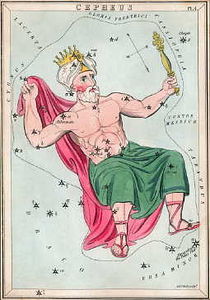Cepheus (constellation)
| Constellation | |
List of stars in Cepheus |
|
| Abbreviation | Cep |
|---|---|
| Genitive | Cephei |
| Pronunciation | /ˈsiːfiəs/ or /ˈsiːfjuːs/; genitive /ˈsiːfiaɪ/ |
| Symbolism | The King/King Cepheus |
| Right ascension | 22 h |
| Declination | +70° |
| Quadrant | NQ4 |
| Area | 588 sq. deg. (27th) |
| Main stars | 7 |
| Bayer/Flamsteed stars |
43 |
| Stars with planets | 1 |
| Stars brighter than 3.00m | 1 |
| Stars within 10.00 pc (32.62 ly) | 3 |
| Brightest star | α Cep (Alderamin) (2.45m) |
| Nearest star | Kruger 60 (13.15 ly, 4.03 pc) |
| Messier objects | 0 |
| Meteor showers | None |
| Bordering constellations |
Cygnus Draco Ursa Minor |
| Visible at latitudes between +90° and −10°. Best visible at 21:00 (9 p.m.) during the month of November. |
|
Cepheus is a constellation in the northern sky. It is named after Cepheus, King of Aethiopia in Greek mythology, and is considered to represent a king. It was one of the 48 constellations listed by the 2nd century astronomer Ptolemy, and remains one of the 88 modern constellations.
Contents |
Notable features
Stars
γ Cephei is a binary star approximately 50 light years away from Earth. The system consists of an orange subgiant and a red dwarf. Due to the precession of the equinoxes, γ Cephei will be the pole star between AD 3000 and 5200, with the closest approach to the celestial pole around AD 4000. The primary component is orbited by a planet.
δ Cephei is the prototype Cepheid variable. It was discovered to be variable by John Goodricke in 1784. It varies between 3.5m and 4.3m over a period around 5.4 days.
There are three red giants in the constellation that are visible to the naked eye. The first, μ Cephei, is also known as Herschel's Garnet Star due to its deep red colour. It is a semiregular variable star that varies between 3.4m and 5.1m over a period of 730 days. The star is around 11.8 AU in radius. If it were placed at the centre of our Solar System, it would extend to the orbit of Saturn. The second, VV Cephei, is also variable and ranges from 4.8m and 5.4m over a period around 20 years. The third red supergiant is HR 8164, whose apparent magnitude is 5.66m. Each of the stars are among the largest known.
Kruger 60 is an 11th magnitude binary star consisting of two red dwarfs. The star system is one of the nearest being only 13 light years away from Earth.
Deep sky objects
- NGC 188 is an open cluster that has the distinction of being the closest open cluster to the north celestial pole, as well as one of the oldest known open clusters.
- The Fireworks Galaxy (NGC 6946) is a spiral galaxy in which nine supernovae have been observed, more than in any other galaxy.
- The nebula NGC 7538 is home to the largest yet discovered protostar.
Visualizations

The stars of Cepheus form a shape approximately like a box with a triangle on top. When fainter stars visible to the naked eye are included, Cepheus can be interpreted as looking like a king with a crown (upside down with respect to the ecliptic).
Mythology
Together with other constellations nearby (Andromeda, Perseus, Cassiopeia, and possibly Pegasus), and the constellation Cetus below Cepheus, this may be the source of the myth of the Boast of Cassiopeia, with which it is usually identified.
In the TV comedy 3rd Rock From The Sun, the aliens' home planet is given as located in a barred spiral galaxy on the Cepheus-Draco border.
References
- Ian Ridpath and Wil Tirion (2007). Stars and Planets Guide, Collins, London. ISBN 978-0007251209. Princeton University Press, Princeton. ISBN 978-0691135564.
External links
|
|||||
|
||||||||||||||||||||||||||||||||